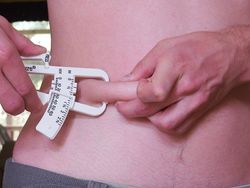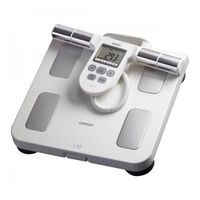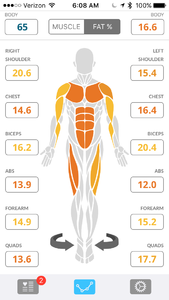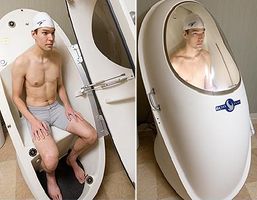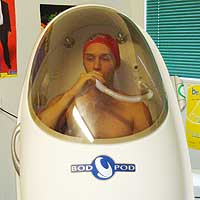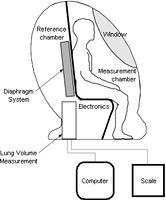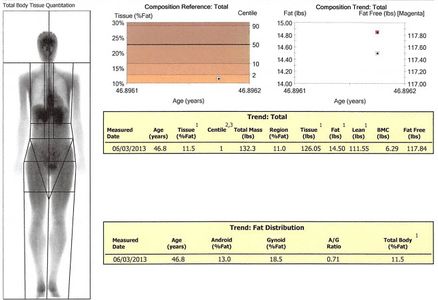Difference between revisions of "Body Fat Measures"
User:Fellrnr (User talk:Fellrnr | contribs) (Created page with 'Body Fat Measures This is a comparison of the ways that body fat can be measured. None of the approaches is perfect, but they can be useful. ==Skinfold Calipers== These are chea…') |
User:Fellrnr (User talk:Fellrnr | contribs) |
||
| (13 intermediate revisions by 2 users not shown) | |||
| Line 1: | Line 1: | ||
| − | + | Measuring your body fat is an important way of evaluating your diet and your training. No technique is accurate and all approaches are estimates based on indirect measures. However, there are a number of cost effective and practical approaches you can use. Personally, I use [[Skulpt]] and [[Body Fat Scales]] to track moving daily changes, and periodic DEXA scans to calibrate. | |
| − | + | =Skinfold Calipers= | |
| − | + | ''Main article: [[Skinfold Calipers]]'' | |
| − | |||
| − | http:// | + | This is the cheapest way of getting a viable estimate of your own body fat. The calipers are extremely cheap ($5 from [http://go.fellrnr.com?id=35454X937677&xs=1&url=http%3A%2F%2Fwww.amazon.com%2FAccu-Measure-Fitness-3000-Personal-Tester%2Fdp%2FB000G7YW74 Amazon.com]) and directly measure your body fat. They do require some practice to get repeatable results, but the price, performance and convenience makes them an ideal starting point. |
| + | [[File:Skinfold-4.jpg|none|thumb|250px|Accu-measure calipers in action]] | ||
| + | =Body Fat Scales= | ||
| + | ''Main article: [[Body Fat Scales]]'' | ||
| − | + | These scales use an imperceptible electrical signal to estimate body fat. This makes these scales quick and easy to use, and the accuracy of the scales that measure from the hands and feet is quite reasonable. I recommend the Omron HBF-510, which retails for about $60-$65 on [http://www.amazon.com/Omron-HBF-510W-Composition-Monitor-Scale/dp/B001IV61J4 Amazon.com]. | |
| − | These | + | [[File:Omron HBF-510.jpg|none|thumb|200px|The most cost effective body fat scale, the Omron HBF-510.]] |
| − | + | =Skulpt= | |
| − | + | ''Main article: [[Skulpt]]'' | |
| − | http:// | + | Skulpt uses a similar principle to body fat scales, sending an imperceptible electrical current through the skin. Instead of measuring overall body fat through 2 or 4 electrodes on your limbs, Skulpt uses 12 electrodes close together to measure body fat over an area of about 2" x 3" (5cm x 8cm). You then use the sensor up to 24 different body locations. This provides more information about body fat in specific locations, and I found a reasonable agreement with DEXA. The sensor will also evaluate "muscle quality", an approach that seems to have a relatively good scientific basis. |
| + | <gallery widths=300px heights=300px class="center"><gallery> | ||
| + | File:Skulpt.jpg| The Skulpt device | ||
| + | File:Skulpt App (3).png| A screen shot from the Skulpt app | ||
| + | </gallery> | ||
| + | =BOD POD= | ||
| + | This is a chamber that works out your body volume accurately. Given the volume and weight you have the density, from which you can estimate body composition. This is the same principle used in underwater weighing, but far less unpleasant. The test costs about $25 at a gym, which makes it expensive to use regularly. There are two types of BOD POD, a recreational and a research model; The recreational model is used by many gyms and estimates lung function, whereas the research model actually measures lung volume. I found the BOD POD quick and easy, but the combination of the cost and the trip to a gym makes it tricky to use on a frequent basis. See http://www.bodpod.com/ for more details. | ||
| + | <gallery widths=300px heights=200px caption="Bodpod"> | ||
| + | File:Bodpod open closed.jpg|The shows the Bodpod open and closed, which gives a sense of the size. If you're claustrophobic the bodpod may be oppressively small but for most people it should be fine. | ||
| + | File:Bodpod lung test.jpg|This image shows the lung testing action. The bodpod I used did not have this lung adapter. | ||
| + | File:Bodpod schematic.jpg|this schematic gives a sense of how bodpod works. | ||
| + | </gallery> | ||
| + | =DEXA= | ||
| + | ''Main article: [[DEXA]]'' | ||
| − | + | Different tissues in the body absorb different frequencies of X-Rays at different levels. This technique (Deal-Energy X-Ray Absorpiometry) uses two frequencies of X-Rays and looks at the different absorption to work out body fat. This is the current 'gold standard' for clinical body fat measurement and provides a detailed breakdown of body fat and lean tissue in different areas of the body. | |
| − | + | [[File:DEXA page 1.jpg|none|thumb|x300px|This is the first page of a DEXA report that gives an overview of body fat composition.]] | |
| − | + | =Underwater Weighing= | |
| − | |||
| − | |||
| − | |||
| − | |||
| − | |||
| − | This is a | ||
| − | |||
This used to be the 'gold standard' of body fat measurement. The technique involves being weighed on dry ground and then again underwater having breathed out as much as possible. This gives a value of density, so it should have similar accuracy as the BOD POD, but is more expensive and unpleasant. I have not tried this technique. | This used to be the 'gold standard' of body fat measurement. The technique involves being weighed on dry ground and then again underwater having breathed out as much as possible. This gives a value of density, so it should have similar accuracy as the BOD POD, but is more expensive and unpleasant. I have not tried this technique. | ||
| − | + | =Alternatives to Measurement= | |
| − | |||
| − | |||
These approaches can give some hint about your body fat, but are no substitute for a real measurement. | These approaches can give some hint about your body fat, but are no substitute for a real measurement. | ||
| − | + | ==Waist to Hips Ratio== | |
This does not directly measure body fat, but is a crude measure of health. A ratio of 0.7 for women and 0.9 for men is correlated with good health. This is a crude measure, but can be useful for an initial evaluation. | This does not directly measure body fat, but is a crude measure of health. A ratio of 0.7 for women and 0.9 for men is correlated with good health. This is a crude measure, but can be useful for an initial evaluation. | ||
| − | + | ==Body Mass Index== | |
This is a simple figure based on your height and weight, and gives no real indication of body fat. If you are overweight it can give a sense of your health risk, but overall it's quite useless. | This is a simple figure based on your height and weight, and gives no real indication of body fat. If you are overweight it can give a sense of your health risk, but overall it's quite useless. | ||
| − | + | ==Mirror== | |
Looking at yourself in a mirror is a simple method that can give a sense of body fat. Obviously there is no numerical quantity to this test, but it's cheap and easy. | Looking at yourself in a mirror is a simple method that can give a sense of body fat. Obviously there is no numerical quantity to this test, but it's cheap and easy. | ||
| − | + | ==Abdominal Muscle Definition== | |
| − | If your body fat is low enough, the definition in your abdominal muscles (six pack) can be used to monitor body fat changes. | + | If your body fat is low enough, the definition in your abdominal [[Muscle|muscles]] (six pack) can be used to monitor body fat changes. There is no specific body fat percentage for having a six-pack, but the common thought is that you need to be 12-8% for men and 18-14 for women. |
| + | [[Category:Beginners]] | ||
| + | [[Category:Training]] | ||
| + | [[Category:Nutrition]] | ||
| + | [[Category:Weight]] | ||
| + | [[Category:Ketogenic]] | ||
| + | [[Category:Review]] | ||
Latest revision as of 10:20, 22 April 2019
Measuring your body fat is an important way of evaluating your diet and your training. No technique is accurate and all approaches are estimates based on indirect measures. However, there are a number of cost effective and practical approaches you can use. Personally, I use Skulpt and Body Fat Scales to track moving daily changes, and periodic DEXA scans to calibrate.
Contents
1 Skinfold Calipers
Main article: Skinfold Calipers
This is the cheapest way of getting a viable estimate of your own body fat. The calipers are extremely cheap ($5 from Amazon.com) and directly measure your body fat. They do require some practice to get repeatable results, but the price, performance and convenience makes them an ideal starting point.
2 Body Fat Scales
Main article: Body Fat Scales
These scales use an imperceptible electrical signal to estimate body fat. This makes these scales quick and easy to use, and the accuracy of the scales that measure from the hands and feet is quite reasonable. I recommend the Omron HBF-510, which retails for about $60-$65 on Amazon.com.
3 Skulpt
Main article: Skulpt
Skulpt uses a similar principle to body fat scales, sending an imperceptible electrical current through the skin. Instead of measuring overall body fat through 2 or 4 electrodes on your limbs, Skulpt uses 12 electrodes close together to measure body fat over an area of about 2" x 3" (5cm x 8cm). You then use the sensor up to 24 different body locations. This provides more information about body fat in specific locations, and I found a reasonable agreement with DEXA. The sensor will also evaluate "muscle quality", an approach that seems to have a relatively good scientific basis.
4 BOD POD
This is a chamber that works out your body volume accurately. Given the volume and weight you have the density, from which you can estimate body composition. This is the same principle used in underwater weighing, but far less unpleasant. The test costs about $25 at a gym, which makes it expensive to use regularly. There are two types of BOD POD, a recreational and a research model; The recreational model is used by many gyms and estimates lung function, whereas the research model actually measures lung volume. I found the BOD POD quick and easy, but the combination of the cost and the trip to a gym makes it tricky to use on a frequent basis. See http://www.bodpod.com/ for more details.
- Bodpod
5 DEXA
Main article: DEXA
Different tissues in the body absorb different frequencies of X-Rays at different levels. This technique (Deal-Energy X-Ray Absorpiometry) uses two frequencies of X-Rays and looks at the different absorption to work out body fat. This is the current 'gold standard' for clinical body fat measurement and provides a detailed breakdown of body fat and lean tissue in different areas of the body.
6 Underwater Weighing
This used to be the 'gold standard' of body fat measurement. The technique involves being weighed on dry ground and then again underwater having breathed out as much as possible. This gives a value of density, so it should have similar accuracy as the BOD POD, but is more expensive and unpleasant. I have not tried this technique.
7 Alternatives to Measurement
These approaches can give some hint about your body fat, but are no substitute for a real measurement.
7.1 Waist to Hips Ratio
This does not directly measure body fat, but is a crude measure of health. A ratio of 0.7 for women and 0.9 for men is correlated with good health. This is a crude measure, but can be useful for an initial evaluation.
7.2 Body Mass Index
This is a simple figure based on your height and weight, and gives no real indication of body fat. If you are overweight it can give a sense of your health risk, but overall it's quite useless.
7.3 Mirror
Looking at yourself in a mirror is a simple method that can give a sense of body fat. Obviously there is no numerical quantity to this test, but it's cheap and easy.
7.4 Abdominal Muscle Definition
If your body fat is low enough, the definition in your abdominal muscles (six pack) can be used to monitor body fat changes. There is no specific body fat percentage for having a six-pack, but the common thought is that you need to be 12-8% for men and 18-14 for women.
- Category:Beginners
- Category:Training
- Category:Nutrition
- Category:Weight
- Category:Ketogenic
- Category:Review
